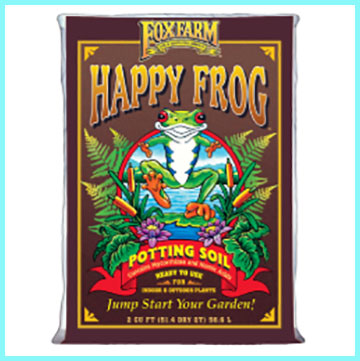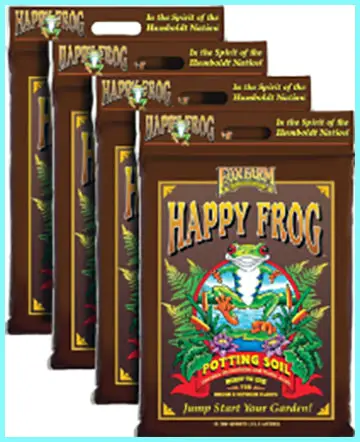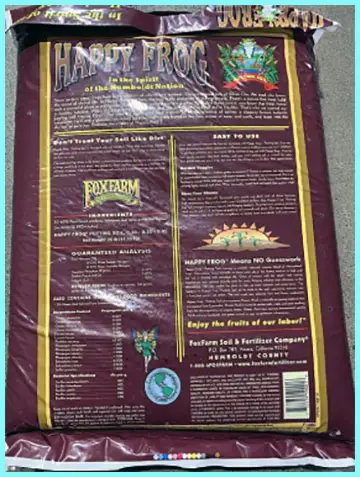I’ve killed my fair share of plants with cheap, dense, “mystery” potting soil from the big-box store. It’s a sad, waterlogged-root story. Then I switched to FoxFarm Happy Frog, and everything changed. It’s the difference between a sad apartment and a 5-star hotel for your plants.
If you’re tired of lackluster growth and want to give your plants the absolute best, nutrient-rich, living soil they can get, you have to make the switch. It’s the secret to a thriving indoor (or outdoor) jungle.
My Experience With Foxfarm Happy Frog Potting Soil
Let me set the scene. For years, I was a mediocre-at-best plant parent. My prized possession was a Fiddle-Leaf Fig named “Finneas” who was in a permanent state of depression. He was tall but spindly, and every time he’d try to push out a new leaf, it would turn brown and crispy. I blamed the light. I blamed my watering. I blamed the humidity. It never once occurred to me to blame the dense, concrete-like soil I had him in.

That all changed when I got into collecting rare and expensive houseplants.
The game changes when you spend $150 on a single, tiny, one-leaf cutting of a Monstera Albo.
You suddenly realize you cannot put your new, high-stakes baby into an $8 bag of generic “potting mix.”
I started doing serious research, which meant lurking on specialty gardening forums and houseplant subreddits.
The community was in a holy war, split between two products from the same brand: FoxFarm Happy Frog and FoxFarm Ocean Forest.
I read countless testimonials. Ocean Forest was described as “hotter” and “richer,” while Happy Frog was the “gentle but powerful” one. I chose Happy Frog, thinking it would be a safer bet for my precious investments.
The first shock was the price. I paid over $30 for a 2-cubic-foot bag. I had a moment of intense buyer’s remorse, thinking, “I just paid $30 for… dirt.”
Then I opened the bag.
It was not dirt. It was the richest, darkest, fluffiest black-gold I had ever seen. It didn’t smell like a musty, damp bag; it smelled earthy, fresh, and alive. The texture was unbelievable. It was light, airy, and soft. You could see the fine peat moss, the little white specks of perlite, and other rich, organic-looking matter. I ran my hands through it. It held moisture, but it didn’t clump or turn to mud. It just felt… high-quality.
I decided to repot Finneas, the sad Fiddle-Leaf, as my first test. The process of repotting was a joy. The soil was so easy to work with. It filled the pot perfectly, surrounding the roots in what looked like a fluffy cloud. I also used it to pot up some robust tomato seedlings and my new, prized Monstera.
The results were not instant, but they were profound.
About three weeks later, I walked by Finneas and stopped dead. Two new, bright-green, glossy leaves were unfurling at the top. This was a plant that hadn’t given me a new leaf in six months. Then I saw another new growth point emerging from a lower node. The plant was, for the first time, thriving.
The tomato seedlings exploded. They were noticeably thicker-stemmed, a darker shade of green, and more robust than any seedlings I had ever grown. The Monsteras and Philodendrons I potted in it started rooting so fast, I could see new roots at the bottom of the nursery pots within two weeks.
But the biggest change was the “idiot-proof” factor. This soil saved me from my worst habit: overwatering. Because it is so light and airy, it drains impeccably. I could water my plants, and the excess would flow straight out the bottom, but the soil itself remained perfectly moist. The roots could finally breathe. It made me a better plant parent because the soil was forgiving. It was doing half the work for me.
Read More: Comparison Of Mother Earth Groundswell And Foxfarm Ocean Forest
Pros Of Foxfarm Happy Frog Potting Soil
- It’s Genuinely “Alive” With Microbes And Mycorrhizae: This is the product’s main selling point and what truly sets it apart from sterile, cheap mixes. When I say it smells “alive,” I mean it. Happy Frog is inoculated with a powerful cocktail of beneficial soil microbes and mycorrhizal fungi.1 You’re not just giving your plant soil; you’re giving it a living ecosystem. These tiny organisms form a symbiotic relationship with the plant’s roots. They help break down organic matter into usable nutrients and dramatically increase the root’s ability to absorb water and minerals. This living component is the “magic” that leads to explosive root development and overall plant health. You are building a healthy, living biome from the ground up.
- A Premium, All-In-One Nutrient Charge: The second you read the ingredient list, you understand the price. This isn’t just peat moss and perlite. This soil is amended. It’s packed with high-quality, organic-based ingredients like earthworm castings, bat guano, and composted forest humus. This is a buffet of nutrients. The earthworm castings provide a perfect, slow-release “all-purpose” meal, while the bat guano gives a potent, fast-acting boost of phosphorus and nitrogen. This “hot” (but not too hot) mix means that for the first 3-6 weeks, I don’t have to fertilize at all. The plant has everything it needs. This saved me time and took the guesswork out of feeding my new plants.
- Unmatched Drainage And Aeration (Root Rot’s Worst Enemy): This, for me, is just as important as the nutrients. The number one killer of houseplants is root rot, which is caused by dense, waterlogged soil. Happy Frog is engineered to prevent this. The texture is light, fluffy, and springy. This is thanks to the perfect ratio of aged forest products, high-quality peat moss, and perlite. When I water my plants in this soil, I can literally see the water drain quickly through the pot. This structure ensures that even when the soil is moist, there are still air pockets. This allows the roots to breathe, preventing suffocation and rot. It’s almost impossible to overwater a plant in this soil if you have a pot with a drainage hole.
- Incredible Texture And Consistency: One of my biggest pet peeves with cheap soil is the stuff I find in it. I’ve found rocks, bits of plastic, huge, un-composted wood chips, and mysterious clumps. Happy Frog is the opposite. Every bag I have ever purchased has had the exact same perfect, consistent, fine-particle texture. It’s dark, rich, and “clean.” It’s easy to work with and feels great in my hands. This consistency means I know exactly what my plants are getting, every single time. It also doesn’t become “hydrophobic” when it dries out—that’s when water just pools on the surface and won’t absorb. This soil re-wets beautifully, every time.
Cons Of Foxfarm Happy Frog Potting Soil

- The Sticker Shock: It’s Extremely Expensive
- Cost Per Pot: This is the most obvious and unavoidable con. A 2-cubic-foot bag can cost anywhere from $30 to $40, depending on where you buy it. A generic, store-brand bag of the same size might be $8. This price difference is massive. It makes you feel like you’re potting your plants in gold.
- Justification Is Difficult: If you’re just potting up some simple, hardy spider plants or a golden pothos, it’s almost impossible to justify this cost. It feels like total overkill. The price relegates it to a “special occasion” soil for most people. I only use it for my most expensive, prized plants or for plants I’m trying to rehabilitate. I can’t afford to fill my large outdoor planters with it.
- The “Living Soil” Dark Side: Fungus Gnats
- The Gnat Cloud: This is the #1 complaint I see on every single forum, and I have experienced it myself. Because the soil is alive and full of rich, decomposing, organic-based matter (like humus and guano), it is a 5-star resort and breeding ground for fungus gnats. I have opened brand-new, sealed bags and had a small puff of tiny black flies emerge.
- It’s A Trade-Off: This is the unfortunate price you pay for not using a sterile, “dead” soil. The gnats aren’t harmful to an established plant (though their larvae can eat tender, new roots), but they are an absolute nuisance in your home. It’s a real, frustrating con that adds a new “pest control” step to my potting process.
- The Nutrient Profile Isn’t One-Size-Fits-All
- A Bit “Hot” For Delicate Seedlings: While I sang its praises for my tomato seedlings, those were already established seedlings I was potting up. If you are starting seeds from scratch, this soil can be too rich. The nutrient load, often called “hot” soil, can “burn” the tiny, delicate roots of a brand-new sprout. You are much better off using a sterile, nutrient-free “seed-starting” mix and then transplanting into Happy Frog once the seedling has its first true leaves.
- The Nutrients Are Finite: A lot of people buy this, see the incredible initial growth, and then get disappointed six months later when the plant’s growth slows. They think the soil has “failed.” The reality is, this isn’t a magic, self-replenishing soil. Your plant is a hungry teenager. It will consume that initial buffet of guano and castings in about 4-6 weeks of vigorous growth. After that, the “food” is gone. You must start a regular fertilizing routine. It’s a “starter” pack, not a “forever” solution.
Maintenance Tips For Foxfarm Happy Frog Potting Soil

- Winning The War On Gnats (Before It Starts)
- The Mosquito Bit Tea Method: This is my non-negotiable first step. I never use the soil straight from the bag anymore. I buy “Mosquito Bits,” which contain a natural bacteria (BTI) that is harmless to plants but lethal to gnat larvae. Before I pot a plant, I put a tablespoon of the bits into my watering can, let it “steep” for 20 minutes, and then use that BTI-infused water to moisten the new, dry soil in a mixing tub. This pre-treatment kills any dormant eggs or larvae before they can ever hatch and infest my house.
- Sterilizing (The Last Resort): Some people will tell you to sterilize the soil by baking it in the oven or microwaving it. I strongly advise against this. Yes, it will kill the gnat eggs. But it will also kill every single one of those beneficial microbes and mycorrhizae that you just paid $30 for. You are essentially turning your premium, living soil into a sterile, dead, expensive brick of peat.
- Bottom-Watering And Sticky Traps: Once your plant is potted, the best defense is a good offense. I always have yellow sticky traps in my pots to catch any adult fliers. And I try to bottom-water my plants. Fungus gnats lay their eggs in the top 1-2 inches of moist soil. If you let that top layer get bone-dry while watering from the bottom, you create an inhospitable environment for them. Happy Frog’s fluffy texture wicks water up from a saucer beautifully.
- The Perfect Feeding And Watering Routine
- Use The “Finger Test” (And Trust It): This soil is a beautiful, dark black. It will look wet on the surface long after it’s dry an inch or two down. Conversely, its fluffy nature means the top can look dry when it’s still perfectly moist below. You must break your habit of watering on a schedule. Use your finger. I stick my entire index finger two inches down. If I feel any moisture at all, I walk away. The aeration in this soil is its best feature; don’t ruin it by overwatering.
- Start Fertilizing At Week 5: Do not add fertilizer when you first pot a plant in Happy Frog. You will burn the roots, guaranteed. The soil is already loaded. I wait about 4-6 weeks, or until I see the first major burst of new growth slow down. Then, I start my own liquid fertilizing routine (I use FoxFarm’s “Grow Big” or “Tiger Bloom”) at 1/2 the recommended strength, once every two weeks. The soil is now a “vehicle,” and I am the “chef.”
- Flush Your Soil Every Few Months: Because this soil starts so rich in organic-based nutrients (salts), and then I add more liquid fertilizer (more salts), these can build up in the soil over time. This can eventually lead to chemical burn on the roots. Every 3-4 months, I take my plants to the sink or shower and flush the pot. I let lukewarm water run through the soil for 5-10 minutes. This dissolves and washes away all the excess salt buildup, giving the roots a fresh start.
- Customizing Your Mix For Peak Performance
- The Perfect Aroid Mix: As good as Happy Frog is, it’s not the “perfect” mix for my fussy Aroids (Monsteras, Philodendrons) that crave a super-chunky mix. So, I use Happy Frog as a base. My go-to “Aroid Mix” is: 1 part Happy Frog, 1 part orchid bark, and 1 part extra perlite or pumice. This creates an incredibly airy, chunky, and well-draining mix that still has that rich, microbial-loaded soil base.
- Stretching The Bag: Let’s be honest: this stuff is expensive. If I’m potting up a large, simple plant (like a 10-gallon snake plant), I’ll “stretch” the bag. I’ll mix 50% Happy Frog with 50% of a cheaper, “clean” potting mix (like a basic peat/perlite blend). This lowers the cost, but I still get the microbial and nutrient benefits of the FoxFarm soil.
Comparison With Other Brands

- Versus FoxFarm Ocean Forest
- The “Hotter” Sibling: This is the most common comparison, and it’s the brand’s other superstar. I’ve used Ocean Forest as well, and the difference is real. Ocean Forest is hotter (more nutrient-rich) and has a different ingredient list, including fish emulsion and crab meal. The texture is a bit heavier and denser than Happy Frog. I find Ocean Forest is incredible for the vegetative growth stage of very heavy-feeding plants (like tomatoes or cannabis). But it is much more likely to burn sensitive plants or new cuttings. I consider Happy Frog the “safer,” more versatile, all-purpose potting soil, while Ocean Forest is a specialized, high-octane fuel.
- Versus “Big Box” Store Brands (Miracle-Gro, Sta-Green)
- Organic vs. Synthetic: When I compare Happy Frog to a bag of classic Miracle-Gro Potting Mix, the entire philosophy is different. Miracle-Gro is “soil-less media” (peat/perlite) that gets its nutrients from synthetic, chemical slow-release pellets (the little blue or green balls). Happy Frog’s nutrients are organic-based and living (guano, castings, microbes). Miracle-Gro’s texture is known to break down and compact into mud within a year. Happy Frog holds its light, fluffy structure for much, much longer. It’s the difference between a fast-food meal (Miracle-Gro) and a whole-food, organic-based dinner (Happy Frog).
- Versus Boutique “Living Soil” Brands (Roots Organics, SoHum)
- Peers in “Premium”: When I look at a bag of Roots Organics Original, I’m in the same class. Both are premium, “living soils” loaded with microbes and high-end organic-based amendments. My experience is that they are very similar, and choosing between them is like choosing between two luxury car brands. It often comes down to local availability and personal preference.
- The “Water-Only” Super Soils: Then you have brands like SoHum Living Soil. This stuff is the next level up. It’s engineered to be a “water-only” soil that contains everything a plant needs for its entire life cycle, from seedling to harvest. It is also significantly more expensive than Happy Frog. Happy Frog is not this. Happy Frog is a premium starter soil that gives you a 4-6 week head start. SoHum is a “just add water” full-cycle solution.
Also Read: My Thoughts On Pearl’s Premium Grass Seed
Frequently Asked Questions (FAQ)
Yes, it is a fantastic, high-quality potting soil. It is famous for its light, airy texture and its “living” blend of beneficial microbes, mycorrhizae, and premium, organic-based nutrients like bat guano and earthworm castings.
The main downside of FoxFarm Ocean Forest is that it is very “hot,” or nutrient-rich. This high nutrient load can easily “burn” (damage) seedlings, new cuttings, or sensitive plants. It is less forgiving than Happy Frog.
It is a premium, all-purpose, “living” potting soil. It’s designed to be a step above generic mixes, focusing on a healthy soil biome (microbes) and high-quality amendments to promote vigorous root growth and healthy plants.
Its unique blend of living ingredients. The combination of beneficial soil microbes, mycorrhizal fungi, earthworm castings, and bat guano, all in a light, airy, peat-based soil, creates a rich, “alive” ecosystem for plant roots.
Conclusion
Ultimately, FoxFarm Happy Frog is an investment. It’s not the cheap option, and it’s not perfect (I’m looking at you, fungus gnats). But my plants don’t lie. The explosive growth, the healthy root systems, and the sheer vibrancy of my plant collection after I made the switch are all the proof I need. If you’re a serious plant parent, or you’re just tired of watching your plants “survive” when you want them to “thrive,” you need to get a bag. Your plants will thank you, and the results will make you feel like a gardening expert.
